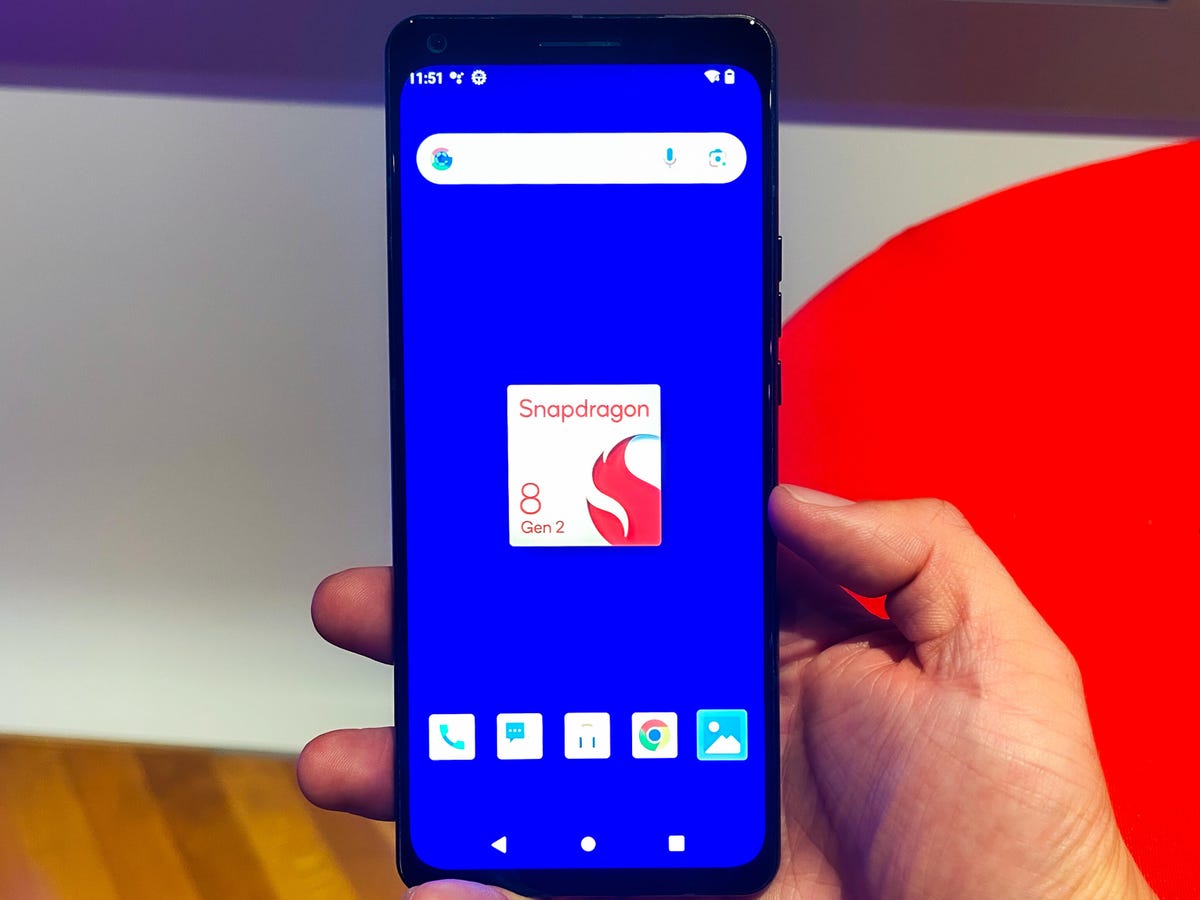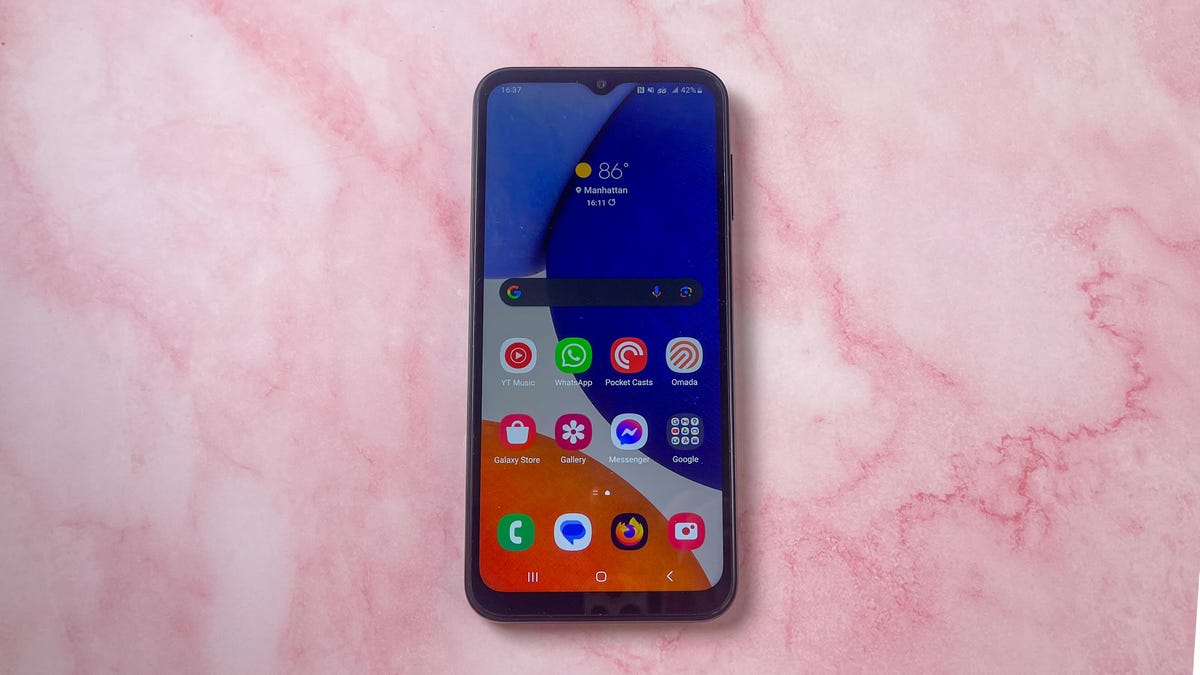I review a lot of phones that cost $300 or less. And I’m always surprised by how many of these cheap phones have high-end features that used to be exclusive to expensive smartphones, like a high refresh rate display. Despite those advances, one thing I’ve come to expect on any phone under $300 is a mediocre camera.
For instance, I snagged a number of beautiful photos in Central Park on a bright sunny day with the $250 Moto G 5G. But when I took the phone to a Motorola Razr Plus launch event inside a darker venue, the images looked so bad that I had to switch to my personal iPhone 12 Pro Max in order to grab decent shots of the entertainment, Cirque du Soleil and Kim Petras.

But in a darker environment, this wider shot of Kim Petras was the best photo I could get on the Moto G 5G.
While device makers like Motorola, Samsung and OnePlus design the hardware and software for affordable phones, it’s Qualcomm who is largely behind the processor design. And the San Diego-based company might have a solution to improve those so-so cameras on cheap phones.
A phone’s processor can help improve the photos you take by reducing image noise and expanding the dynamic range. Qualcomm, widely known for its Snapdragon 8 processors in the Samsung Galaxy S23 line and OnePlus 11, creates several series of chips for the affordable phone market. For instance the $300 OnePlus Nord N30 5G runs on Qualcomm’s midrange Snapdragon 695, part of the company’s 6 series. The aforementioned Moto G 5G runs on the Snapdragon 480 Plus, part of the more value-focused 4 series.
Part of the challenge of designing lower-end chips is that they might end up in phones coming out next year or even years after. The Snapdragon 480 Plus for instance was first revealed in 2021. So Qualcomm’s designers must plan for a slower rollout of features along a much longer timeframe as components like high display refresh rates, better connectivity and improved cameras trickle down to cheap phones.
Qualcomm’s newest 4 series chip, the Snapdragon 4 Gen 2 chip, was first announced in June and prioritizes improving photos. The new processor supports low-light photo processing that uses artificial intelligence to make images look better. While there isn’t a US phone with the new chip that’s out yet, diving into what the new processor supports might offer clues about what we can expect from upcoming affordable phones here.
As such, I visited Qualcomm’s San Diego headquarters in July to learn more about how the company develops chips for affordable phones and what that means for future sub-$300 phones.
Inside Qualcomm HQ’s Appointment-Only Museum Filled With Retro Phones
Improving photography, with a little bit of AI
After price, cameras are often the biggest deciding factor for people choosing a phone. Qualcomm’s senior director of product management for the Snapdragon 4 Gen 2, Deepu John, told CNET that improving image quality is a big focus with the new processor.
“If you’re sitting in a bar taking pictures of beer or some exotic food item that you ordered, you want to be able to boast about that on Instagram,” said John.
The Snapdragon 4 Gen 2 uses artificial intelligence to assist with photo processing and improve images taken in low light. AI and computational photography are already common on more expensive phones. For instance, Google designed its own Tensor chip to handle photo processing on its Pixel phones. John notes that building AI into the chip’s camera support was a priority for Qualcomm, because people notice photo quality the most.

Qualcomm also makes emulator devices that function much like a finished Android phone, which further helps the company see how the processor might interact with components like cameras.
Faster 5G and refresh rates
Cameras aren’t the only area where cheap phones lag behind. It wasn’t until 2023 that the first sub-$200 phones with 5G were released. 5G support requires pricey modems to work. And it’s much easier for a phone with a higher price tag to absorb that cost. Qualcomm had to factor in the cost when designing the Snapdragon 4 Gen 2.
“One of the things we really focused on was manufacturer cost, because again, we’re trying to get 5G down. So that sounds weird, but 5G is almost a premium feature still,” Lopatka said.
Qualcomm focused on optimizing its new chip for cheaper phones without sacrificing performance, which required choosing specific types of memory and components. Lopatka and John said that these are often decisions that still meet the people’s needs, but lower the overall cost of the processor.

The $200 Samsung Galaxy A14 5G is one of the top-selling phones of 2023 so far, and includes a Mediatek processor.
Competition in the lower-end
Qualcomm’s Snapdragon 4 Gen 2 faces stiff competition from Mediatek for inclusion in affordable phones. The $200 Samsung Galaxy A14 5G series has a MediaTek Dimensity 700 chip. According to Counterpoint Research, the A14 5G was the top-selling Android phone in the US for the month of July, and placed fifth overall behind four iPhone models. Samsung, Motorola and OnePlus did not comment for this story.
While Apple does not currently sell an iPhone under $400, Google’s Pixel 6A running on its in-house Tensor chip starts at $349 while occasionally dipping to $299 on sale.
When asked about these potential rivals to the Snapdragon 4, Lopatka and John said that while Qualcomm does monitor rival companies, the market would ultimately decide the better product.
“It may come across as simple as [an] X-megapixel camera or dual ISP or something, but to sustain that is tough. And that’s what we constantly are driving, leading on the technology and that’s where we really stand out,” John said.
Regardless of competition, seeing processors like Qualcomm’s Snapdragon 4 Gen 2 gives hope that better photography could become a more universal feature on your next phone, whether you spend $200 or $1,200. But until we have a cheaper phone that handles night photography with ease, I’m still going to be cautious about relying on one while I’m out at a dark concert.
Editors’ note: CNET is using an AI engine to help create some stories. For more, see this post.
